NCERT Solutions Class 10 Social Science Chapter 1 The Rise of Nationalism in Europe have been provided below and is also available in Pdf for free download. The NCERT solutions for Class 10 Social Science have been prepared as per the latest syllabus, NCERT books and examination pattern suggested in Class 10 by CBSE, NCERT and KVS. Questions given in NCERT book for Class 10 Social Science are an important part of exams for Class 10 Social Science and if answered properly can help you to get higher marks. Refer to more Chapter-wise answers for NCERT Class 10 Social Science and also download more latest study material for all subjects. Chapter 1 The Rise of Nationalism in Europe is an important topic in Class 10, please refer to answers provided below to help you score better in exams
Chapter 1 The Rise of Nationalism in Europe Class 10 Social Science NCERT Solutions
Class 10 Social Science students should refer to the following NCERT questions with answers for Chapter 1 The Rise of Nationalism in Europe in Class 10. These NCERT Solutions with answers for Class 10 Social Science will come in exams and help you to score good marks
Chapter 1 The Rise of Nationalism in Europe NCERT Solutions Class 10 Social Science
The Rise of Nationalism in Europe
Points to Remember:
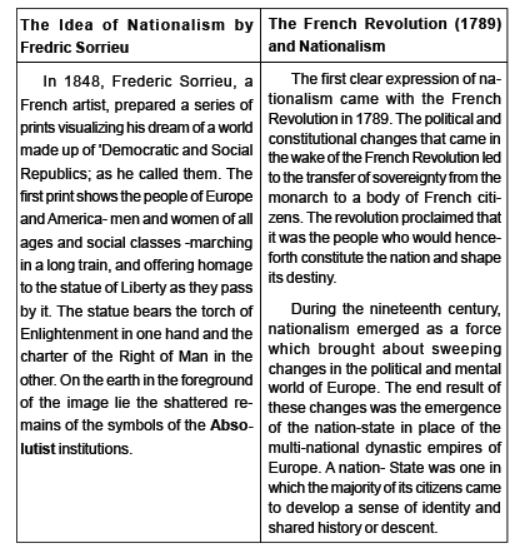
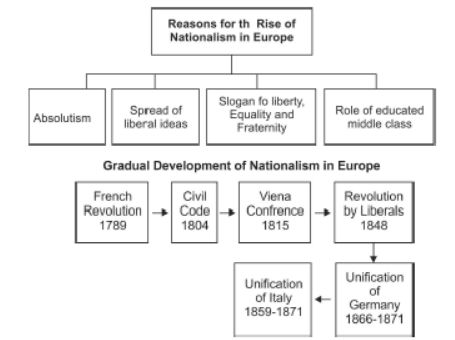
From the very begining of the French Revolution, the French revolutionaries introduced various measures and practices that could create a sense of collective identity (nationalism) amongst the French people. Later, Napoleon introduced revolutionary reforms in the administrative field which is known as Civil Code of 1804 (The Napoleonic Code). Further, the ideas of national unity (Nationalism) in the early nineteenth-century Europe were closely allied to the ideology of liberalism.
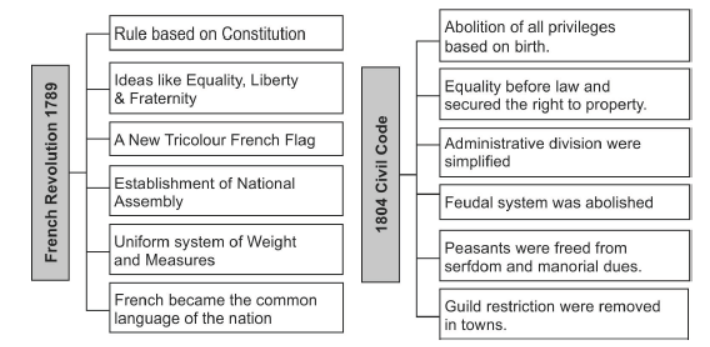

Conservatism in Europe after 1815
Napoleon was defeated in 1815 and after this European governments were driven by a spirit of conservatism. As a political philosophy, conservatism stressed on the importance of tradition established institutions and custom, and preferred gradual development to quick change. In the background, a summit (called the Congress) was organized at Vienna. The congress was hosted by the Austrian chancellor, Duke Matternich. The Treaty of Vienna was signed in this congress.
Duke Matternich
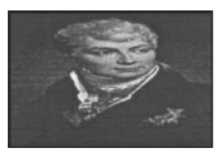
He was the Austrian Chancellor. He was born on 15th May 1773. He had once remarked that "When France sneezes the rest of Europe catches cold". He took a prominent part in Congress of Vienna and dominated the European politics from 1814 to 1848. He acted as the restorer of the 'old Regime' and the reconstruction of Europe after the Napoleonic wars.
Giuseppe Mazzini
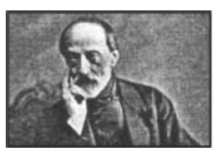
He was born in Genoa in 1807. He became a member of secret society of the Carbonari. As a young man of 24, he was sent to exile in 1831 for attempting a revolution in Liguria. He subsequently founded two more underground societies, first, Young Italy in Marseilles and then, Young Europe in Berne. Mazzini's relentless opposition to monarchy and his vision of democratic republics frightened the conservatives. Matternich described him as 'the most dangerous enemy of our social order'.
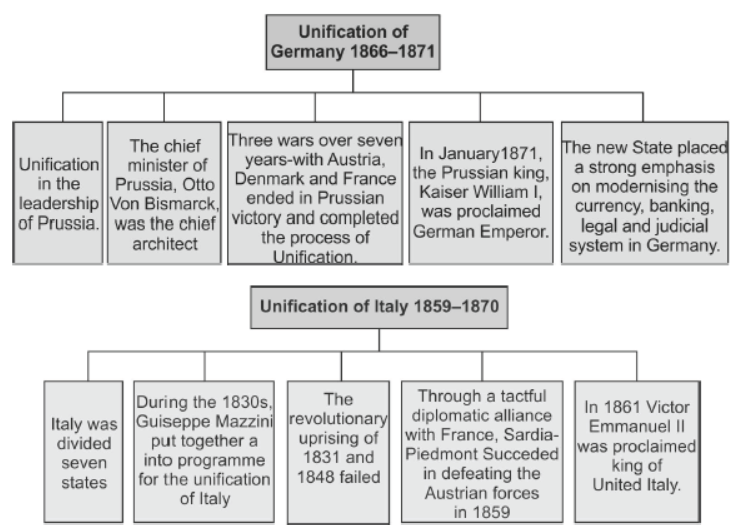
Count Camillo of Cavour
He was the Chief Minister of Sardia-Piedmont.
He led the movement to unify the regions of Italy though he was neither a revolutionary nor a democrat.
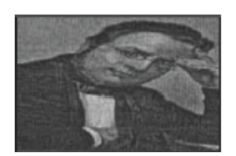
The tactful diplomatic alliance with France was also engineered by Cavour and thus Austria could be defeated and the Unification of Italys was made possible.
Giuseppe Garibaldi
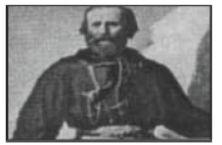
He was not part of the regular Troops. He led armed volunteers for the unification of Italy. In 1860, he along with armed volunteers marched into South Italy and the kingdom of two Sicilies and succeded in winning the Support of the local peasants in order to drive out the Spanish rulers. He handed over control of Southern Italy and Sicily to king Emmanuel II and thus Unification of Italy could be made possible.
Greek War of Independence
Greek was the part of the Ottoman Empire since 15th century. The growth of revolutionary nationalism (after French Revolution, 1789) sparked off a struggle for Independence among Greeks. The struggle for independence stated in 1821. Nationalists in Greece got support from the other Greeks living in exile and also from many west Europeans. Many poets and artists mobilized public opinion to support Greece struggle. The English poet Lord Byron organized funds and later went to fight in the war, where he died of fever in 1824. The Treaty of Constantinople of 1832 recognized Greece as on independent nation.
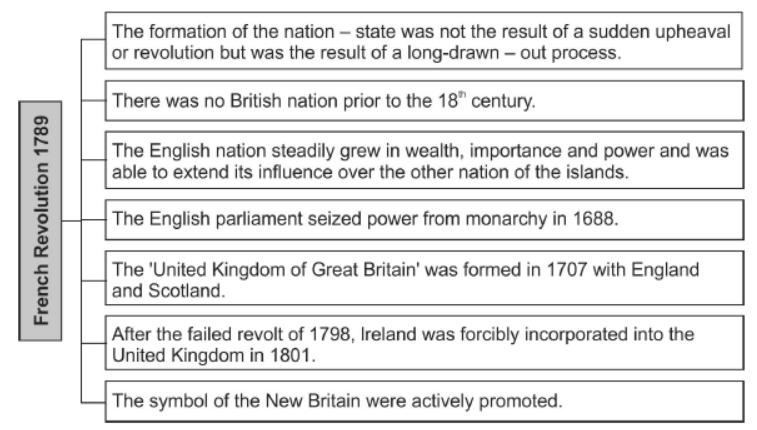
Nationalism and Imperialism (Balkan Problem)The balkans was a region of geographical and ethnic variations comprising modern day Romania, Bulgaria, Albania, Greece, Macedonia, Croatia, Slovenia, Serbia etc. whose inhabitants were broadly known as the Slavs. A large part of the Balkans was under the control of Ottoman Empire. The spread of the ideas of romantic nationalism in the Balkans together with the disintegration of the Ottoman Empire made this region very explosive. One by one, European Subject nationalities broke away and declared their Independence. As the different Slavic nationalities struggled to define their identity and independence, the Balkan area became an area of intense conflict. The Balkan states hope to gain more territory at the expenses of the others. During this period, there was intense rivalry among the European powers for control over this area. This further complicated the matter. This led to a series of wars in the region and finally the First World War.
Visualizing the Nation
Artists in the 18th and 19th centuries portrayed a country as if it were a person (Nations were portrayed as a Female Figure). The female form that was chosen to personify the nation did not stand for any particular woman in real life; rather it sought to give the abstract idea of the nation a concrete form. Thus, female figure became an allegory of the nation. In France, she was christened Marianne, a popular Christian name, which under lined the idea of the people's nation. Similarly, Germania became the allegory of the German nation.
Frankfurt Parliament
In the German regions a large number of political associations whose members were middle-class professionals, businessmen and prosperous artisans came together in the city of Frankfurt and decided to vote for an all- German National Assembly. On 18 May 1848, 831 elected representatives marched in a festive procession to take their places in the Frankfurt parliament convened in the Church of St Paul. They drafted a constitution for a German nation to be headed by a monarchy subject to a parliament. When the deputies offered the crown on these terms to Friedrich Wilhelm IV, King of Prussia, he rejected it and joined other monarchs to oppose the elected assembly. While the opposition of the aristocracy and military became stronger, the social basis of parliament eroded. The parliament was dominated by the middle classes who resisted the demands of workers and artisans and consequently lost their support. In the end troops were called in and the assembly was forced to disband.
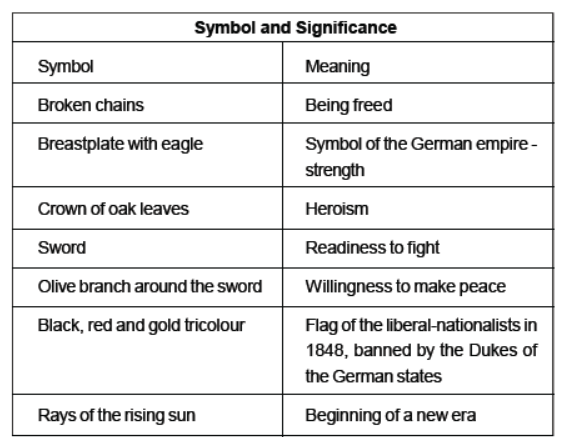
Postage stamp of 1850 Picture of Marianne was printed on it which represented the Republic of France.
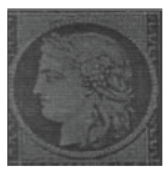
This picture was made by painter Philip Vetit in 1848. This was meant to hang from the ceiling of the Church of St. Paul where the Frankfurt Parliament was convened
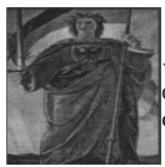
Various symbols which were used to depict the development of Nationalism.
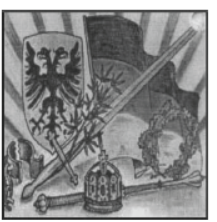
Major Statements
"When France sneezes the rest of Europe catches cold."
(Metternich)
"Mazzini is the most dangerous enemy of our social order."
(Metternich)
Answer the following Questions
Very Short Questions:
Question. Who was Frederic Sorrieu?
Answer. French Artist
Question. Who was Duke Metternich?
Answer. Austrian Chancellor
Question. Which Principle was propounded by Montesquieu?
Answer. Segrigation of power
Question. What was zollvereinl How was it responsible for the economic unification of Germany?
Answer. A custom union, mostly German states. Established in 1834 which ended the tarrif barrier and reducedthe currencies from over thirty to two. This way it was a symbol of economic unification.
Question. Name the region Whose inhabitants were broadly known as Slavs?
Answer. Balkan
Question. Which Treaty recognized Greece as an independent Nation?
Answer. Treaty of constitinople
Question. Who spearheaded the protestant movement in Ireland?
Answer. Volftone
Question. Rewrite the sentence after correcting the underlined word
(i) Cavour is considered as the Bismarck of Germany.
(ii) In January 1871, the Prussian king, William I, was proclaimed Italian Emperor in a ceremony held in Versailles.
(iii) Vienna Congress was organised in 1817.
(iv) Rosseau said when France Sneeze rest of the world catches cold.
Answer. (i) Italy
(ii) Germany
(iii) 1815
(iv) Metternich
Question. Find the correct Match.
A. Bismarck - Italy
B. Mazzini - Germany
C. Cavour - Britian
D. Meternich - Austria
Answer. Metternich - Austria
Question. Which among the following statements is NOT related to the Unification of Italy?
A. Guiseppe Mazzini formed a secret society for the dissemination of his goals.
B. Chief minister Cavour led the movement to unify the regions of Italy.
C. In 1861, Victor Emmanuel II was proclaimed as the king of United Italy.
D. Otto Von Bismarck, was the architect of the unification of Italy.
Answer. Auto Von Bismark
Question. Identify this image
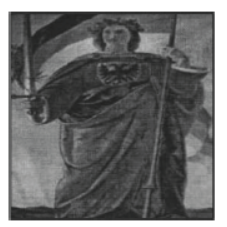
Answer. Germania
Question. Fill in the Blanks-
................. adopted the policy of blood and iron for the unification of Germany.
Answer. Bismark
Question. State Whether True or False.
Garibaldi formed the Red Shirt army of volunteers.
Answer. True
Question. In the question given below, there are two statements marked as Assertion (A) and Reason (R). Read the statement and choose the correct option:
Assertion: (A) After 1848, nationalism in Europe moved away from its association with democracy and revolution.
Reason: (R) Nationalist feelings were widespread among middle - class family.
Option
A. Both A and R are true and R is the correct explanation of
B. Both A and R are true and but R is not the correct explanation of
C. A is correct and R is Incorrect.
D. A is wrong but R is correct.
Answer. Both A and R are true and but R is not the correct explanation of A
Question. In the question given below, there are two statements marked as Assertion (A) and Reason (R). Read the statement and choose the correct option:
Assertion (A): The Bourbon dynasty removed after French Revolution was restored.
Reason (R): Treaty of Vienna was signed in 1815.
Option
A. Both A and R are true and R is the correct explanation of
B. Both A and R are true and but R is not the correct explanation of
C. A is correct and R is Incorrect.
D. A is wrong but R is correct
Answer. Both A and R are true and R is the correct explanation of A
Question. What were the steps taken by the French revolutionaries to create a feeling of collective identity among the French people?
Answer. 1. (i) Patriarchy and Idea of Citizenship
(ii) New National symbols
(iii) Centralised Administrative system
(iv) National language
(v) Uniform weights and measurement
Question. "Napoleon's administrative measures had revolutionized the whole administration". Comment.
Answer. Napoleonic Code
(i) Improvement In the rural administrative system
(ii) Improvement in urban area
(iii) Improvement in Trade
Question. Discuss the role played by culture in creating the European concept of nation.
Answer. Contribution of culture in the rise of Nation
(i) Growth of nationalist feelings through art, poetry, stories, music etc.
(ii) Folklore,
(iii) Emphasis on local languages and dialect
(iv) Language
(v) Building of culture on the basis of folktales
Question. Which factors were responsible for the rise of nationalism in Europe?
Answer. Reasons for the rise of Nationalism-
(i) Growth of Nation-states
(ii) Encouragement of democratic rights.
(iii) Enforcement on Social, Political and Economic equality
(iv) Demand of human rights in different nations
(v) Revolutionary reactions in absolute monarchical systems.
Question. " The French Revolution left an indelible mark on the world history."
Evaluate this statement.
Answer. Impact of French Revolution-
(i) Establishment of democratic rule,
(ii) Foundation of new society based on equality, liberty and fraternity,
(iii) New code of law
(iv) Rise of middle class
(v) Growth of liberal ideas
Source Based Questions
1. Read the extracts and answer the following questions.
In a lecture delivered at the University of Sorbonne in 1882, the French philosopher Ernst Renan (1823-92) outlined his understanding of what makes a nation. The lecture was subsequently published as a famous essay entitled 'Qu'est-ce qu'une nation?' ('What is a Nation?'). In this essay Renan criticizes the notion suggested by others that a nation is formed by a common language, race, religion, or territory: 'A nation is the culmination of a long past of endeavors, sacrifice and devotion. A heroic past, great men, glory, that is the social capital upon which one bases a national idea. To have common glories in the past, to have a common will in the present, to have performed great deeds together, to wish to perform still more, these arc the essential conditions of being a people. A nation is therefore a large-scale solidarity ... Its existence is a daily plebiscite ... A province is its inhabitants; if anyone has the right to be consulted, it is the inhabitant. A nation never has any real interest in annexing or holding on to a country against its will. The existence of nations is a good thing, a necessity even. Their existence is a guarantee of liberty, which would be lost if the world had only one law and only one master.'
Question. Who was Ernst Renan?
Answer. French Philosopher
Question. What were the key features of Nation according to Ernst Renan?
Answer. Common Language, Race, Religion
Question. Describe the role of Nation for the existence of Liberty?
Answer. Nation is a guarantee of libertiy
Question. Define the nation in your own words?
Answer. Student will define in own words.
2. Read the extracts and answer the following questions.
Economists began to think in terms of the national economy. They talked of how the nation could develop and what economic measures could help forge this nation together.
Friedrich List, Professor of Economics at the University of Tubingen in Germany, wrote in 1834: The aim of the zollverein is to bind the Germans economically into a nation. It will strengthen the nation materially as much by protecting its interests externally as by stimulating its internal productivity. It ought to awaken and raise national sentiment through a fusion of individual and provincial interests. The German people have realized that a free economic system is the only means to engender national feeling.'
Question. What was aim of Zollverein?
Answer. Bind the Germans economically into anation.
Question. Who was Friedrich List?
Answer. Professor of Economics
Question. Mention the importance of free economic system?
Answer. Engender National feelings
Question. What was the role of Economy in forging the nation together?
Answer. Students will solve by thenselves
NCERT Solutions for Class 10 Social Science History for chapter 1 The Rise of Nationalism in Europe
Write in Brief
1. Write a note on:
a) Guiseppe Mazzini
b) Count Camillo de Cavour
c) The Greek war of independence d) Frankfurt parliament
e) The role of women in nationalist struggles
Answer:
a) Guiseppe Mazzini Giuseppe Mazzini was an Italian revolutionary. He fought for the creation of nation-states. He was a member of the secret society of the Carbonari. He was sent into exile in 1831 for attempting a revolution in Liguria. He founded two underground societies named 'Young Italy' in Marseilles and 'Young Europe' in Berne. His societies had members from Poland, France, Italy and the German states.
b) Count Camillo de Cavour - Cavour was the Chief Minister of Sardinia-Piedmont. He led the movement to unify the regions of Italy. He was neither a revolutionary nor a democrat. Like many other wealthy and educated members of the Italian elite, he spoke fluent French. He made a diplomatic alliance with France and defeated the Austrian forces in 1859. In 1860, armed volunteers under the leadership of Giuseppe Garibaldi marched into South Italy and the Kingdom of the Two Sicilies. In 1861 Victor Emmanuel IIwas proclaimed king of united Italy.
c) The Greek war of independence- The Greek war of independence intensified nationalist feelings among the educated elite across Europe. Greece had been part of the Ottoman Empire since the fifteenth century. The growth of revolutionary nationalism in Europe inspired the Greeks for independence in 1821. Nationalists in Greece got support from other Greeks living in exile and also from many West Europeans who had sympathies for ancient Greek culture. Poets and artists lauded Greece as the cradle of European civilisation and mobilised public opinion to support its struggle against the Ottoman Empire. The English poet Lord Byron organised funds and later went to fight in the war, where he died of fever in 1824. Finally, the Treaty of Constantinople of 1832 recognised Greece as an independent nation.
d) Frankfurt Parliament - The Frankfurt parliament was an all-German National Assembly formed by the middle-class professionals and businessmen belonging to the different German regions. In May 1848, 831 elected representatives marched in a procession to take their places in the Frankfurt parliament convened in the Church of St Paul. They drafted a constitution for a German nation to be headed by a monarchy regulated by a parliament. However, Friedrich Wilhelm IV, King of Prussia, rejected the monarchy offered on the constitutional terms. While the opposition of the aristocracy and military became stronger, the social basis of parliament eroded. The parliament was dominated by the middle classes who resisted the demands of workers and artisans and consequently lost their support.
e) The role of women in nationalist struggles - The issue of extending political rights to women was a controversial one among the European liberals fighting for nations. Women had formed their own political associations, founded newspapers and taken part in political meetings and demonstrations. Despite this they were denied suffrage rights during the election of the Assembly. When the Frankfurt parliament was convened in the Church of St Paul, women were admitted only as observers to stand in the visitors' gallery.
2. What steps did the French revolutionaries take to create a sense of collective identity among the French people?
Answer. (i) The French revolutionaries introduced various measures and practices in order to create a sense of collective identity amongst the French people.
(ii)They introduced the ideas of Ia patrie (the fatherland) and /e citoyen (the citizen) to emphasize the notion of a united community with equal rights under a constitution.
(iii)A new French flag, the tricolour, replaced the former royal standard.
(iv)The Estates General was elected by the body of active citizens and renamed the National Assembly.
(v)New hymns were composed, oaths taken and martyrs commemorated, all in the name of the nation.
(vi) A centralised administrative system with uniform laws for all citizens was introduced.
(vii)Internal customs duties and dues were abolished and a uniform system of weights and measures was adopted.
(viii)Regional dialects were discouraged and French, as it was spoken and written in Paris, became the common language of the nation.
3. Who were Marianne and Germania? What was the importance of the way in which they were portrayed?
Answer. Marianne: Female allegories were invented by artists in the nineteenth century to represent the nation. In France she was christened Marianne, a popular Christian name, which underlined the idea of a people's nation. Her characteristics were drawn from those of Liberty and the Republic - the red cap, the tricolour, the cockade. Statues of Marianne were erected in public squares to remind the public of the national symbol of unity. Marianne images were also marked on coins and stamps.
Germania: Germania was the allegory of the German nation. In visual representations, Germania wears a crown of oak leaves, as the German oak stands for heroism.
4. Briefly trace the process of German unification.
Answer. (i)Idea of nation became popular among middle-class Germans.
(ii)In 1848, they tried to unite the different regions of the German confederation into a nation-state governed by an elected parliament.
(iii)The armed forces of the monarchy suppressed this liberal initiative to nation-building. The large landowners (called Junkers) of Prussia also prevented the emergence of German nation.
(iv)Prussia's chief minister, Otto von Bismarck, was the architect of the German unification with the help of the Prussian army and bureaucracy.
(v)Three wars over seven years - with Austria, Denmark and France - ended in Prussian victory and completed the process of unification.
(vi)In January 1871, the Prussian king, William I, was proclaimed German Emperor at Versailles.
5. What changes did Napoleon introduce to make the administrative system more efficient in the territories ruled by him?
Answer. (i)Napoleon introduced in Europe many reforms that he had already implemented in France. However, by establishing monarchy Napoleon had also destroyed democracy in France.
(ii)In the administrative field, his reforms had some of revolutionary principles in order to make the whole system more rationaI and efficient.
(iii)The Civil Code of 1804 (also known as the Napoleonic Code) did away with all privileges based on birth, established equality before the law and protected the right to property. This Code was also implemented in the regions under French control.
(iv)In the Dutch Republic, in Switzerland, in Italy and Germany, Napoleon simplified administrative divisions, abolished the feudal system and freed peasants from serfdom and manorial dues.
(v) In the towns, he removed guild restrictions and improved transport and communication systems. Peasants, artisans, workers and new businessmen enjoyed a new-found freedom.
(vi)Businessmen and small-scale producers of goods realised the importance of uniform laws, standardised weights and measures for their business growth. Introduction of a common national currency facilitated the transport of goods and capitaI from one region to another.
Discuss
1. Explain what is meant by the 1848 revolution of the liberals. What were the political, social and economic ideas supported by the liberals?
Answer. The 1848 Liberal Revolution: In the year 1848, when the poor, unemployed and starving peasants and workers were revolting in many European countries, a revolution led by the educated middle classes was emerging. Revolutionary events of February 1848 in France had ended the monarchy and a republic based on universal male suffrage had been proclaimed.
Political Ideas: Ideas of national unity in early nineteenth-century Europe were closely allied to the ideology of liberalism. In Germany, Italy, Poland and the Austro-Hungarian Empire, the liberal middle classes politically united themselves and demanded the creation of a nation-state on parliamentary principles - a constitution, freedom of the press and freedom of association. In the German regions, many political associations were formed by the middle-classes in the city of Frankfurt. However, Liberals had contradicting views on the issue of extending political rights to women.
Social ideas: The liberals wanted to end monarchy through political revolutions and rearrange the social base on national unity and individual rights; they were against kingship and birth rights, and wanted to eradicate feudal values in Europe.
Economic ideas: The liberalists supported the freedom of markets and the abolition of state-imposed restrictions on the movement of goods and capital. During the nineteenth century, this was a strong demand of the liberals. Nineteenth-century liberals also stressed the inviolability of private property.
2. Choose three examples to show the contribution of culture to the growth of nationalism in Europe.
Answer. The following three examples show the contribution of culture to the growth of nationalism in Europe:
(i) Romanticism, a cultural movement in Europe, sought to develop a particular form of nationalist sentiment. Romantic artists and poets criticised the glorification of reason and science and focused instead on emotions, intuition and mystical feelings. Their effort was to create a sense of a shared collective heritage, a common cultural past, as the basis of a nation.
(ii) Folk songs, folk poetry and folk dances contributed to the true spirit of the nation (volksgeist). So collecting and recording various forms of folk culture was part of the project of nation-building. Vernacular language and local folklore recovered ancient national spirit and also took the modern nationalist message to large audiences who were mostly illiterate. For example, in Poland, Karol Kurpinski celebrated the national struggle through his operas and music, turning folk dances like the polonaise and mazurka into nationalist symbols.
(iii) Language too played an important role in developing nationalist sentiments. After Russian occupation, the Polish language was banned in schools and the Russian language was imposed everywhere. In 1831, an armed rebellion against Russian rule took place which was ultimately crushed. Following this, many members of the clergy in Poland began to use language as a weapon of national resistance. The use of Polish came to be seen as a symbol of the struggle against Russian dominance.
3. Through a focus on any two countries, explain how nations developed over the nineteenth century.
Answer. Before emerging as nations, Germany and Italy were divided into kingdoms, duchies and cantons whose rulers had their autonomous territories.
Germany: Idea of nation became popular among middle class Germans; in 1848, they tried to unite the different regions of the German confederation into a nation-state governed by an elected parliament. The armed forces of the monarchy suppressed this liberal initiative to nation building. Prussia's chief minister, Otto von Bismarck, was the architect of the German unification. Three wars over seven years - with Austria, Denmark and France - ended in Prussian victory and completed the process of unification. In January 1871, the Prussian king, William I, was proclaimed German Emperor at Versailles.
Italy: During the 1830s, Giuseppe Mazzini had proposed a programme for a unitary Italian Republic. He had also formed a secret society called Young Italy for this purpose. Due to the failure of revolutionary uprisings in 1831 and 1848, King Victor Emmanuel II, the ruler of Sardinia-Piedmont, attempted to unify the Italian states through war. The ruling elites of this region wanted a unified Italy for economic development and political dominance. Later, Cavour, the Chief Minister of Sardinia Piedmont led the movement to unify the regions of Italy. He made an alliance with France and defeated the Austrian forces in 1859. In 1860, armed volunteers under the leadership of Giuseppe Garibaldi marched into South Italy and the Kingdom of the Two Sicilies. In 1861, Victor Emmanuel II was proclaimed king of united Italy.
4. How was the history of nationalism in Britain unlike the rest of Europe?
Answer. (i)In Britain, the formation of the nation-state was the result of a long-drawn-out process.
(ii)The primary identities of the people in the British Isles were ethnic ones (such as English, Welsh, Scot or Irish). They had their own cultural and political traditions. There was no idea of nation and national unity among these ethnic groups.
(iii)The English nation which was wealthy and powerful dominated the other nations of the islands.
(iv)The English parliament had seized power from the monarchy in 1688, after a long conflict. Following this, it forged a nation-state, with England at its centre.
(v)With the enactment of the Act of Union (1707) between England and Scotland, the 'United Kingdom of Great Britain' was born. However, England continued its political supremacy on Scotland in the British parliament.
(vi)The growth of a British identity systematically destroyed Scotland's distinctive culture and political institutions.
(vii)The Catholic clans of the Scottish Highlands were suppressed when they demanded freedom. They were forbidden to speak their Gaelic language or wear their national dress, and many were forcibly driven out of their homeland.
(viii)In Ireland, a country deeply divided between Catholics and Protestants, the English helped the Protestants of Ireland to establish their dominance over a largely Catholic country.
(ix)After the failure of Catholic revolts led by Wolfe Tone and his United Irishmen (1798) against British dominance, Ireland was forcibly incorporated into the United Kingdom in 1801.
(x)A new 'British nation' emerged with a dominant English culture. National symbols of the new Britain - the British flag (Union Jack), the national anthem (God Save Our Noble King), the English language - were actively promoted and the older nations became subordinate partners in this union.
5. Why did nationalist tensions emerge in the Balkans?
Answer. (i)The Balkans witnessed a serious nationalist tension in Europe after 1871.
(ii)It was a region of geographical and ethnic variation comprising modern-day Romania, Bulgaria, Albania, Greece, Macedonia, Croatia, Bosnia-Herzegovina, Slovenia, Serbia and Montenegro whose inhabitants were broadly known as the Slavs.
(iii)Most of regions in the Balkans were under the control of the Ottoman Empire. The ideas of romantic nationalism spread in the region with the disintegration of the Ottoman Empire.
(iv)The Balkan peoples based their claims for independence on nationality. They claimed with historical evidence that they had been subjugated by foreign powers. All Slavic nationalities struggled to define their identity and independence.
(vi)The Balkan states tried to gain more territory at the expense of the others.
(v)The region also witnessed conflicts among the European powers over trade and colonies. Russia, Germany, England, Austro-Hungary tried to extend their own control over the area. This led to a series of wars in the region and finally the First World War.
Important Questions for NCERT Class 10 Social Science The Rise Of Nationalism In Europe
Question. What was Zollverein?
Answer. Zollverein was customs union formed in 1834 at the initiative of Prussia and joined by most of the German sates.
Question. What do you know about young Italy?
Answer. Young Italy was a secret society, formed by Giuseppe Mazzini to establish a unitary Italian Republic.
Question. Explain the role of languages in developing the nationalist sentiments in Europe.
Answer. Poland had been partitioned at the end of the 18th century by ‘The Great Powers, Russia, Prussia and Austria. Even though Poland no longer existed as an
independent country but national feelings were kept alive through the language.
(i) The emphasis on language was made not just to recover an ancient national spirit but also to carry the modern nationalist message to large audiences who were mostly illiterate.
(ii) After the Russian occupation of Poland, Polish language was forced out of schools and the Russian language was imposed everywhere.
(iii) Many members of the clergy in Poland began to use language as a weapon of national resistance.
(iv) Polish was used for church gathering and all religious instructions.
(v) The use of Polish thus came to be seen as a symbol of struggle against Russian dominance.
Question. Give a brief account of political fragmentation of Italy.
Answer. (i) Like Germany, Italy too had a long history of political fragmentation.
(ii) Italians were scattered over several dynastic states as well as the multinational, Habsburg Empire.
(iii) During the middle of the nineteenth century, Italy was divided into seven states, of which only one, Sardinia-Piedmont, was ruled by an Italian princely house.
(iv) The north was under Austrian Habsburgs, the centre was ruled by the Pope and the southern regions were under the domination of the Bourbon kings of Spain.
(v) Even the Italian language had not acquired one common form, and it still had many regional and local variations.
Question. Unification of Germany took place between which period?
(a) 1860 to 1871
(b) 1870 to 1871
(c) 1856 to 1871
(d) 1866 to 1871
Answer. D
Question. What was the significance of ‘Broken Chains’?
(a) Being freed
(b) Heroism
(c) Readiness to fight
(d) Willingness to make peace
Answer. A
Question. Enumerate any three features of the conservative regimes set up in Europe following the defeat of Napoleon in 1815?
Answer. (i) The conservatives emphasised the importance of tradition’s customs and established institutions like the monarchy, the church, the social hierarchies, property and the family.
(ii) The power of the Bourbon dynasty was restored.
(iii) Steps were taken to prevent French expansion and creation of new states.
(iv) Autocratic regimes came into power. Descent of any type from any group was not tolerated. The ideas associated with French Revolution were censored.
Question. Describe the impact of ‘The Revolution of the Liberals’ in 1848 in Europe.
Answer. The word ‘liberal’ is derived from the Latin ‘liber’ that means ‘free’. Liberalism means a political system or tendency opposed to centralisation and absolutism. It emphasises on absolute and unrestrained freedom of thought, religion, conscience, creed, speech, press, and politics. Liberals believed that government is necessary to protect individuals from being harmed by others, not to pose a threat to liberty.
In nineteenth century a series of republican revolts started against European monarchies. It began in Sicily and spread over to France, the German and Italian states, and the Austrian Empire. This was the time when the liberals became active. Their significant role in political and economic fields changed the outlook of European countries.
In the economic field
(i) Liberals in the 19th century urged the end of state interference in the economic life of society.
(ii) They fought for the freedom of markets and the abolition of state-imposed restrictions on the movement of goods and capital.
(iii) In 1834, a customs union or zolverein was formed at the initiative of Prussia and joined by most of the German states.
(iv) The union abolished tariff barriers and reduced the number of currencies from thirty to two.
(v) The construction of a network of railways stirred economic growth and economic nationalism which eventually strengthened nationalism.
In the political field
(i) Primary aim of liberals was to establish freedom for the individual and equality of all before the law.
(ii) It believed that government should be formed with the consent of people.
(iii) It was against autocracy and clerical privileges and favoured a constitution and representative government through parliament.
(iv) During that time property-owning men only had right to vote and get elected.
(v) The Napoleonic Code also preferred limited suffrage and reduced women’s role also.
(vi) Women were considered as the subject to the authority of fathers and husbands.
(vii) This led to the rise of movement by women and non-propertied men demanding equal political rights.
Question. What was the main function of the Prussian Zollverein?
Answer. Its main function was to abolish tariff barriers.
Question. Who was proclaimed the German Emperor after its unification?
Answer. The Prussian King William I was proclaimed the German Emperor after its unification.
Question. Who was Frederic Sorrien?
(a) A French philosopher
(b) A French leader
(c) A French artist
(d) A French cartoonist
Answer. C
Question. Who was described as the ‘most dangerous enemy to our social order’ and by whom?
Answer. Mazzini was described as the ‘most dangerous enemy to our social order’ by Metternich.
Question. What did the French revolutionaries aim for?
Answer. The French revolutionaries aimed for:
(i) Creating a sense of collective responsibility.
(ii) Establishing republic.
(iii) Equal rights for all.
VERY SHORT ANSWER TYPE QUESTIONS
Question. What was the major change that occurred in the political and constitutional scenario due to the French Revolution in Europe?
Answer: It led to the transfer of sovereignty from the monarchy to a body of French citizens. The revolution proclaimed that it was the people who would henceforth constitute the nation and shape its destiny.
Question. What was the main aim of the French revolutionaries?
Answer: The main aim of the French revolutionaries was to create a sense of collective identity amongst the French people. They proclaimed that it was the people who would constitute the nation and shape its decisions.
Question. What is the meaning of concentration camps?
Answer: Concentration camps are prisons where people are detained and tortured without due process of law.
Question. Name the Treaty of 1832 that recognised Greece as an independent nation.
Answer: Treaty of 1832: Constantinople
Question. Name the event that mobilised nationalist feelings among the educated elite across Europe in 1830-1848?
Answer: The Greek War of Independence in 1821.
Question. What was the main aim of revolutionaries of Europe during the years following 1815?
Answer: The main aim of revolutionaries of Europe was to oppose monarchial forms of government.
Question. Who remarked “when France sneezes the rest of Europe catches cold”.
Answer: Duke Metternich
Question. Who was proclaimed German Emperor in a ceremony held at Versailles in January 1871?
Answer: Kaiser William I of Prussia was proclaimed German Emperor in a ceremony held at Versailles in January 1871.
Question. Who was proclaimed the King of United Italy in 1861?
Answer: Victor Emmanuel-II
Question. Who was Frederic Sorrieu?
Answer: Frederic Sorrieu was a French artist who visualised a world, made up of democratic and social republics, and put his dream down in a series of four prints.
Question. What is referred to as Absolutism?
Answer: Unrestricted, despotic and authoritarian monarchial system of rule or government is referred to as absolutism.
Question. Define Nation.
Answer: A body of people who are united by same past, culture, political system and common interests can be defined as a Nation.
Question. What was the concept of a nation-state?
Answer: The concept of a nation-state was one in which people and rulers of land came together to develop a sense of common identity and shared history.
Question. Who hosted the Congress of Vienna in 1815?
Answer: Duke Metternich hosted the Congress of Vienna in 1815.
Question. What was main aim of the Treaty of Vienna of 1815?
Answer: The main aim of the Treaty of Vienna of 1815 was to undo the changes brought about in Europe during the Napoleonic wars.
SHORT ANSWER TYPE QUESTIONS
Question. Explain any three beliefs of the conservatism that emerged after 1815.
Answer: Three beliefs of conservatism that emerged after 1815 were:
• Established and traditional institutions of state and society like monarchy, the Church, property and family should be preserved.
• They believed in the modernization of the traditional institution to strengthen them, rather than returning to the society of pre-revolutionary days.
• Also they believed that abolition of feudalism and serfdom and replacing it with a modern army, an efficient bureaucracy and a dynamic economy could strengthen autocratic monarchies of Europe.
Question. Explain the contribution of Otto von Bismarck in German unification.
Answer: Contribution of Otto von Bismarck in German unification. Nationalist feelings started spreading amongst the middle class Germans, who in 1848, tried to unite different parts of German confederation into a nation state to have an elected parliamentarian government. However, this liberal movement was repressed by the combined forces of monarchy and military supported by Prussian landowners.
Prussian Chief Minister, Otto von Bismarck, took the responsibility of national unification with the help of Prussian army and bureaucracy. Under his leadership he fought three wars over seven years with Austria, Denmark and France. Prussia was victorious in all these wars and the process of unification of Germany was completed as a result of Prussia’s victory over France.
Question. Explain any three ways in which nationalist feelings were kept alive in Poland in the 18th and 19th centuries.
Answer: The three ways in which nationalist feelings were kept alive in 18th and 19th centuries in Poland:
(i) Emphasis on vernacular language. Language played an important role in developing nationalist sentiments. The use of the Polish language came to be seen as a symbol of struggle against Russian dominance. For example, In Poland, following armed rebellion against Russian rule, Polish was used for church gatherings and religious instruction. As a result, a number of priests and bishops were put in jails or sent to Siberia as punishment for their refusal to preach in Russian.
(ii) Emphasis on collection of local folklore. It was not just to recover an ancient national spirit, but also to carry the modern nationalist message to the large audience who were mostly illiterate.
(iii) Use of music to keep the nationalist feeling alive. For example, Karol Kurpinski, celebrated the national struggle through his operas and music, turning folk dances like the polonaise and mazurka into nationalist symbols.
Question. Explain the contribution of Giuseppe Mazzini in spreading revolutionary ideas in Europe.
Answer: The year following 1815, was the period of revolutionaries. Most of the revolutionaries were committed to oppose monarchical forms and to fight for liberty and freedom
One such prominent revolutionary was “Giuseppe Mazzini”, an Italian revolutionary. Mazzini also saw the creation of nation-states as a necessary part in the struggle for freedom. Ele strongly believed in the unification of Italy as a single unified republic which could be the basis of Italian liberty.
Mazzini’s relentless opposition to monarchy and his vision of a democratic republic frightened the Conservatives. His ideas also influenced the revolutionaries of Germany, France, Switzerland and Poland.
Question. Describe any three reforms introduced by Napoleon in the territories he conquered.
Answer: Three reforms introduced by Napoleon in the territories he conquered were:
• The Napoleonic Code —It finished all the privileges based on birth and established equality before law and secured the right to property.
• He simplified administrative divisions, abolished the feudal system and freed peasants from serfdom and manorial dues.
• He introduced uniform laws, standardized weights and measures and common national currency to facilitate the movement and exchange of goods and capital from one place to another.
Question. Explain any three causes of conflict in the ‘Balkan area’ after 1871.
Answer: The nationalist tensions emerged in the Balkans due to the following reasons:
(i) Balkans was a region of geographical and ethnic variation comprising modern-day Romania,
Bulgaria, Albania, Greece, Macedonia, Croatia, Bosnia-Herzegovina, Slovenia, Serbia and Montenegro whose inhabitants were known as the Slavs. A large part of Balkans was under the control of the Ottoman empire.
(ii) After the decline of the Ottoman empire and the growth of romantic nationalism in the
Balkans, the region became very explosive. Its European subject nationalities broke away from its control and declared independence.
(iii) As the different nationalities struggled to define their identity and independence, the Balkan area became an area of intense conflict. The Balkan states were fiercely jealous of each other and each hoped to gain more territory at the expense of others.
(iv) Balkan also became the scene of big power rivalry. Russia, Germany, England, Austria,
Hungry — all big powers were keen in countering the hold of other powers. This ultimately turned Balkan into a war region which eventually provided a minor cause for the First World War.
Question. How did the local people in the areas conquered by Napoleon react to French rule? Explain.
Answer: The reactions of the local population to the French rule were mixed.
Initially, in many places such as Holland and Switzerland, as well as in cities like Brussels, Mainz, Milan and Warsaw, the French armies were welcomed as harbingers of liberty. As new administrative arrangements did not go hand in hand with political freedom, enthusiasm turned into hostility. Increased taxation, censorship, forced conscription into the French armies to conquer the rest of Europe, outweighed the advantages of the administrative changes.
Question. Explain the conditions that were viewed as obstacles to the economic exchange and growth by the new commercial classes during the nineteenth century in Europe.
Answer: In the economic sphere, liberalism stood for the freedom of markets and the abolition of stateimposed restrictions on movement of goods and capital.
• But in the 19th century Napoleon’s administrative measures had created out of countless small principalities a confederation of 39 states. Each possessed its own currency, and weights and measures.
• A merchant travelling from Hamburg to Nuremberg had to pass through 11 custom barriers and pay 5% duty at each one of them.
• As each region had its own system of weights and measures this involved time-consuming calculations.
• Such conditions were viewed as obstacles to economic growth and exchange by the new commercial classes who argued for the creation of a unified economic territory allowing free movement of goods, people and capital.
Question. How had the female figures become an allegory of the nation during nineteenth century in Europe? Analyse.
Answer: Artists in the eighteenth and nineteenth centuries portrayed nations as female figures. The female form, that was chosen to personify the nation, did not stand for any particular woman in real life. Rather it sought to give the abstract idea of the nation in concrete form. That is, the female figure
became the allegory of the nation.
In France, she was named Marianne —a popular Christian name and in Germany, Germania.
Germania wears a crown of oak leaves as the German oak stands for heroism. The characteristics of Marianne were drawn from those of Liberty and Republic —the red cap, the tricolour and cockade.
Question. Describe any three economic hardships faced by Europe in the 1830s.
Answer: Following are the causes of economic hardships in Europe during 1830s:
• Europe had come under the grip of large scale unemployment. In most of the countries there were more seekers of jobs than employment. Cities had become overcrowded and slums had emerged as population from the rural areas migrated to the cities.
• Small producers in towns were often faced with stiff competition from imports of cheap machine- made goods from England where industrialization was more advanced specially in the field of textile production.
• In those regions of Europe, where aristocracy still enjoyed power, peasants struggled under the burden of feudal dues and obligations. The rise of food prices and bad harvests added to the hardships of the peasants.
LONG ANSWER TYPE QUESTIONS
Question. What did Liberal Nationalism stand for? Explain any four ideas of Liberal Nationalists in the economic sphere.
Answer: Liberalism or Liberal Nationalism stood for freedom for the individual and equality of all before the law. Four ideas of Liberal Nationalists in the economic sphere are:
• Liberalism stood for freedom of markets and abolition of state imposed restriction. For example, Napoleon’s administration was a confederation of 29 states, each of these possessed its own currencies, weight and measures. Such conditions were viewed as obstacles to economic exchange.
• Liberal Nationalists argued for the creation of a unified economic territory allowing the unhindered movement of goods, people and capital.
• In 1834, a customs union or ” zollverein” was formed. The union abolished tariff barriers and reduced the number of currencies from 30 to 2.
• The creation of a network of railways further stimulated mobility, harnessing economic interest to national unification.
Question. “Napoleon had, no doubt, destroyed democracy in France, but in the administrative field he had incorporated revolutionary principles in order to make the whole system more rational and efficient.” Support the statement.
OR
State any three provisions of the Civil Code of 1804.
OR
Explain any three features of the Napoleonic code.
OR
Explain any five social and administrative reforms introduced by Napolean in regions under his control.
Answer: Napoleon had brought revolutionary changes in the administrative field in order to make the whole system rational and efficient. The Civil Code of 1804 is usually known as the Napoleonic Code.
• The first major change was doing away with all privileges based on birth, establishing equality before law and securing the right to property.
• Administrative divisions were simplified.
• Feudal system was abolished and peasants were freed from serfdom and manorial dues (abuse of manorial lords).
• In towns, guild restrictions were removed.
• Transport and communication systems were improved.
• Peasants, artisans, workers and new businessmen enjoyed a new found freedom.
• Businessmen and small-scale producers of goods in particular began to realize that uniform laws, standardised weights and measures and a common national currency would facilitate the movement and exchange of goods and capital from one region to another.
Question. How did nationalism develop through culture in Europe? Explain.
OR
Describe the role of culture in shaping the feelings of nationalism in Europe from 1830 to the end of 19th century.
OR
How did culture play an important role in creating the idea of the ‘nation’ in Europe?
Explain with examples.
Answer: Culture, music, dance and religion played an important role in the growth of nationalism.
(i) Role of culture was important in creating the idea of the nation. Art, poetry, music etc. helped in developing and expressing nationalist feelings. Romanticism was a cultural movement that led to the development of nationalist sentiment. Romantic artists and poets criticized the glorification of reason and science and instead focussed on emotions and intuition.
(ii) Artists in the eighteenth and nineteenth centuries portrayed nations as female figures. The female form, that was chosen to personify the nation, did not stand for any particular woman in real life. Rather it sought to give the abstract idea of the nation in concrete form. That is, the female figure became the allegory of the nation. In France, she was named Marianne—a popular Christian name and in Germany, Germania.
(iii) Language too played an important role in developing nationalist sentiments. After Russian occupation, the Polish language was forced out of schools and Russian language was imposed everywhere. In 1831, an armed rebellion against Russian rule took place which was ultimately crushed. Following this, many members of the clergy in Poland began to use language as a weapon of national resistance.
(iv) Romantics such as the German philosopher Herder claimed that true German culture was to be discovered among the common people – das volk. It was through folk songs, folk poetry and folk dances that the true spirit of the nation was popularized.
Question. Explain any five economic hardships that Europe faced in the 1830s.
OR
“The decode of 1830 has brought great economic hardship in Europe”. Support the statement with arguments.
Answer: Following are the causes of economic hardships in Europe during 1830s:
• Europe had come under the grip of large scale unemployment. In most of the countries there were more seekers of jobs than employment.
• Cities had become overcrowded and slums had emerged as population from the rural areas migrated to the cities.
• Small producers in towns were often faced with stiff competition from imports of cheap machine-made goods from England where industrialization was more advanced specially in the field of textile production.
• In those regions of Europe, where aristocracy still enjoyed power, peasants struggled under the burden of feudal dues and obligations.
• The rise of food prices and bad harvests added to the hardships of the peasants.
Question. Describe any three steps taken by the French revolutionaries to create a sense of collective identity amongst the French people.
OR
Describe the events of French Revolution which had influenced the people belonging to other parts of Europe.
OR
Describe any five measures which were introduced by the French Revolutionaries to create a sense of collective identity amongst the French people.
Answer: The first clear-cut expression of nationalism came with the French Revolution in 1789. In 1789, France was under the rule of an absolute monarch.
When the revolutionaries came to power in France, they were determined to create a new sense of unity and nationhood. For this, they emphasized the concept of France being the father land (La Patrie) for all French people, who were from now on addressed as citizens (citoyen). They were given the tri-colour flag, the three colours representing liberty, equality and fraternity. French revolutionaries introduced various other measures such as:
• The Estate General was elected by the body of active citizens and renamed the National Assembly.
• New hymns were composed, oaths taken and martyrs commemorated all in the name of the nation.
• A centralized administrative system was put in place and it formulated uniform laws for all citizens within its territory.
• Internal customs, duties and dues were abolished and a uniform system of weights and measures was adopted.
• Regional dialects were discouraged and French, as it was spoken and written in Paris, became the common language of the nation.
• They further declared that it was the mission and the destiny of the French nation to liberate the people of Europe from despotism and help them to become nations.
Question. How had revolutionaries spread their ideas in many European States after 1815? Explain with examples.
Answer: During the years following 1815, the fear of repression drove many liberal nationalists underground.
• Secret societies sprang up in many European states to train revolutionaries and spread their ideas. Revolutionary ideas were spread by opposing monarchical forms and to fight for liberty and freedom.
• Most of the revolutionaries also saw the creation of nation-states as a necessary part of this struggle for freedom.
• Giuseppe Mazzini was an Italian revolutionary bom in Geneva in 1807. He was a member of the Secret Society of the Carbonari. He attempted a revolution in 1831 and was sent into exile.
• He had set up two more underground societies, namely, Young Italy (1832) in Marseilles and then Young Europe in Berne. The members were like-minded young men from Poland, France, Italy and Germany.
• He opposed monarchy and small states and kingdoms and dreamt of a Democratic Republic. He believed the unification of Italy alone could be the basis of Italian liberty.
Question. How was the Habsburg Empire a patchwork of many different regions and people in Europe? Explain.
Answer: Habsburg Empire was a patchwork of many different regions and people as the Alpine regions— the Tyrol, Austria and the Sudetenland were part of it. The Italian speaking provinces of Lombardy and Venetia were also included in it. Different languages and dialects were spoken by different sections of society throughout the empire. For example, in Bohemia, the nobility or the aristocrats spoke German’ and Lombardy and Venetia were the provinces where Italian was spoken. Polish was the language of aristocracy in Galicia. Besides, these three dominant groups, there also lived peasantry, within the boundaries of Empire such as Bohemians and Slovaks to the north, Slovenes in Carniola, Croats to the south and Roumans to the east in Transylvania. Loyalty to the emperor was the only tie binding these groups that were so different from each other.
Question. Describe the process of unification of Germany.
Answer: Unification of Germany:
In the 18th century, Germany was divided into a number of states. Some of these states ceased to exist during the Napoleonic wars. At the end of the war, there were still 39 independent states in
Germany. Prussia was most powerful, dominated by big landlords known as Junkers.
(i) Nationalist feelings were widespread among middle class Germans who had tried to unite the different regions of the German federation into a nation-state governed by an elected Parliament.
(ii) In May 1848, a large number of political associations came together to vote for an All German National Assembly. Their representatives met at Frankfurt and the Frankfurt Assembly proposed the unification of Germany as a constitutional monarchy under the King of Prussia as emperor. repressed by combined forces of the monarchy, the military and the ‘Junkers’.
(iv) Then on, Prussia under its Chief Minister Otto von Bismarck led the movement for unification of Germany. Bismarck carried out this process with the help of the Prussian army and the bureaucracy. He fought three wars over seven years with Denmark, Austria and France. Prussia was victorious in all these wars and the process of unification was completed as a result of Prussia’s victory over France.
(v) Consequently, on 18th January 1871, an assembly comprising of princes of German states, representatives of the army, important Prussian ministers and Bismarck gathered in the Palace of Versailes and proclaimed the Prussian King, Kaiser William, the new German Emperor.
Question. Explain the process of unification of Italy.
Answer: Italy too had a long history of political fragmentation. Italians were scattered over dynastic states and the multinationals Hamsburg Empire. Italy was divided into seven states. Italian language did not have one common form.
Guiseppe Mazzini had played an important role in the unification of Italy. He formed a secret society called ‘Young Italy’ in Marseilles, to spread his goals. He believed Italy could not continue to be a patchwork of small states and had to be forged into a single unified republic.
During 1830s, Mazzini sought to put together a coherent programme for a unitary Italian Republic. As uprisings in 1831 and 1848 had failed, the mantle now fell on Sardinia-Piedmont under its ruler Emmanuel II to unify Italy. Under Chief Minister Cavour, Sardinia-Piedmont succeeded in defeating the Austrian forces in 1859. He was the chief minister, who led the movement to unify Italy. He formed a tactful diplomatic alliance with France and defeated the Austrian forces. Even Guiseppe Garibaldi joined the fray. In 1860, they marched towards South Italy and the Kingdom of the two Sicilies, and with the help of the local peasants, drove out the Spanish rulers. In 1861, Victor Emmanuel II was proclaimed as King of United Italy.
Question. Describe the process of Unification of Britain.
OR
How has Britain come into existence? Explain.
Answer: Nationalism in Britain was different from the rest of Europe.
(i) Nationalism in Britain was not the result of a sudden uprising or revolution. It was the result of a long drawn out process.
(ii) There was no British nation prior to 18th century. The inhabitants of British Isles were ethnic ones — English, Welsh, Scot or Irish. Though each had their own culture and political traditions, the English nation steadily grew in wealth, importance and power and expanded its influence over other nations, such as Scotland.
(iii) The British Parliament was dominated by its English members. They tried to suppress Scotland’s distinct culture and political institutions. They could neither speak their language nor could they wear their national dress. A large number of them were driven out of their homeland.
(iv) In 1688, through a bloodless revolution the English Parliament seized power from the monarchy and became the instrument to set up a nation-state at its centre.
(v) By the Act of Union in 1707, Scotland was incorporated in the United Kingdom. Though the Irish Catholics were against a union with England, Ireland was forcibly incorporated in United Kingdom in 1801.
(vi) Thus it was parliamentary action and not revolution or war that was the instrument through which the British nation was formed.
(vii) A new ‘British Nation’ was formed through propagation of English culture. The symbols of the New Britain—”the British Flag (Union Jack), National Anthem (God save our noble King) and the English language” were promoted, and the older nations became the subordinate partners in the Union.
Question. Write briefly about the political conditions in Europe in the 1870s.
Answer: The following were the conditions in Europe in the 1870s.
(a) By the last quarter of the 19th century, liberaldemocratic sentiment could not be maintained by the nationalists.
(b) Nationalism was now sought to have narrow aims and beliefs with limited means.
(c) Trust on each other and tolerance among the nationalist groups disappeared.
(d) They just wanted to accomplish their aims at the cost of others.
(e) Even the nationalist aspirations of the subject people were manipulated towards the fulfilment of their imperialistic goals.
(f) A new definition of nationalism emerged which created havoc in the world order. (any five)
Question. Discuss the role played by the women in nationalist struggles.
Answer: Women played a vital role in the nationalist struggles around the world.
(a) Women from many parts of Europe like Germany, Italy and Poland actively supported the liberals demanding constitutional monarchy with national unification.
(b) They too joined their demands for political rights’ like suffrage’ along with the struggle of the liberals. But in spite of their active participation, extension of political rights to them remained a controversial issue.
(c) They took advantage of the unrest in Europe to push their demands for freedom of press and association and creation of a nation-state.
(d) They even formed their own political associations and founded their newspapers.
(e) They held political meetings and staged demonstrations to gain support to their demands. But they were denied suffrage rights during the assembly elections. When the Frankfurt parliament was being convened in the St Paul Church, they were granted admission merely as spectators.
Question. Who were the ‘liberals’? What ideas were supported by them?
Answer: Liberals were the people who demanded freedom and equality. The term liberalism was derive from the Latin root liber which meant ‘to be free’. They wanted to establish a constitutional and parliamentary government with national unification. They advocated freedom for the individual and equality of all before the law. Liberals constituted of professionals, businessmen and prosperous artisans.
The following ideas were supported by the Liberals:
(a) They thought it necessary to create a nation-state on parliamentary principles. They emphasised on the concept of government by consent.
(b) They demanded the formation of a national assembly and drafting of a constitution.
(c) They firmly held the ideas of freedom of press and association.
(d) They asserted that right to vote be granted only to men owning property.
(e) They stressed on the idea of right to private property.
Question. What is the significance of 1848 for France and the rest of Europe? What did the liberals demand?
Answer: In 1848 Europe, the poor, unemployed workers and starving peasants led many revolts. In France, the educated middle class too started a revolution for the abolition of monarchy and establishment of a republic based on universal male suffrage. They took advantage of the growing popular unrest to put forward their demands for the creation of a nation-state based on parliamentary principles with a constitution, freedom of press and association. Political rights for women was an issue in which large number of women took active part. They formed political associations and published newspapers voicing their demands.
Men and women from the liberal middle classes around Europe combined their demands for constitutionalism alongwith national unification.
Question. How did the Greek War of Independence mobilise nationalist feeling among the educated elite across Europe?
Answer: Greece was the part of Ottoman Empire since the fifteenth century.
(a) The Greeks were influenced by the growth of revolutionary nationalism in Europe and they started a struggle for their independence in 1821.
(b) Nationalists in Greece got support from the Greeks residing in different countries.
(c) Even the West European countries sympathised with the Greek and their ancient culture.
(d) Poets and artists too admired Greece as the basis of European civilisation and mobilised public opinion in its support. English poet Lord Byron even organised fund and participated in the war.
(e) Finally, in 1832, Greece was recognised as an independent nation by the Treaty of Constantinople.
| NCERT Solutions Class 10 Social Science Chapter 1 Resources and development |
| NCERT Solutions Class 10 Social Science Chapter 2 Forest and Wildlife Resources |
| NCERT Solutions Class 10 Social Science Chapter 3 Water Resources |
| NCERT Solutions Class 10 Social Science Chapter 4 Agriculture |
| NCERT Solutions Class 10 Social Science Chapter 5 Minerals and Energy Resources |
| NCERT Solutions Class 10 Social Science Chapter 6 Manufacturing Industries |
| NCERT Solutions Class 10 Social Science Chapter 7 Lifelines of the National Economy |
| NCERT Solutions Class 10 Social Science Chapter 1 Power Sharing |
| NCERT Solutions Class 10 Social Science Chapter 2 Federalism |
| NCERT Solutions Class 10 Social Science Chapter 3 Democracy and Diversity |
| NCERT Solutions Class 10 Social Science Chapter 4 Gender Religion and Caste |
| NCERT Solutions Class 10 Social Science Chapter 5 Popular Struggles and Movements |
| NCERT Solutions Class 10 Social Science Chapter 6 Political Parties |
| NCERT Solutions Class 10 Social Science Chapter 7 Outcomes of Democracy |
| NCERT Solutions Class 10 Social Science Chapter 8 Challenges to Democracy |
| NCERT Solutions Class 10 Social Science Chapter 1 The Rise of Nationalism in Europe |
| NCERT Solutions Class 10 Social Science Chapter 2 Nationalism in India |
| NCERT Solutions Class 10 Social Science Chapter 3 The Making of a Global World |
| NCERT Solutions Class 10 Social Science Chapter 4 The Age of Industrialization |
| NCERT Solutions Class 10 Social Science Chapter 5 Print Culture and Modern World |
| NCERT Solutions Class 10 Economics Chapter 1 Development |
| NCERT Solutions Class 10 Economics Chapter 2 Sectors Of The Indian Economy |
| NCERT Solutions Class 10 Economics Chapter 3 Money And Credit |
| NCERT Solutions Class 10 Economics Chapter 4 Globalization And The Indian Economy |
| NCERT Solutions Class 10 Economics Chapter 5 Consumer Rights |
NCERT Solutions Class 10 Social Science Chapter 1 The Rise of Nationalism in Europe
The above provided NCERT Solutions Class 10 Social Science Chapter 1 The Rise of Nationalism in Europe is available on our website for free download in Pdf. You can read the solutions to all questions given in your Class 10 Social Science textbook online or you can easily download them in pdf. The answers to each question in Chapter 1 The Rise of Nationalism in Europe of Social Science Class 10 has been designed based on the latest syllabus released for the current year. We have also provided detailed explanations for all difficult topics in Chapter 1 The Rise of Nationalism in Europe Class 10 chapter of Social Science so that it can be easier for students to understand all answers. These solutions of Chapter 1 The Rise of Nationalism in Europe NCERT Questions given in your textbook for Class 10 Social Science have been designed to help students understand the difficult topics of Social Science in an easy manner. These will also help to build a strong foundation in the Social Science. There is a combination of theoretical and practical questions relating to all chapters in Social Science to check the overall learning of the students of Class 10.
You can download the NCERT Solutions for Class 10 Social Science Chapter 1 The Rise of Nationalism in Europe for latest session from StudiesToday.com
Yes, the NCERT Solutions issued for Class 10 Social Science Chapter 1 The Rise of Nationalism in Europe have been made available here for latest academic session
Regular revision of NCERT Solutions given on studiestoday for Class 10 subject Social Science Chapter 1 The Rise of Nationalism in Europe can help you to score better marks in exams
Yes, studiestoday.com provides all latest NCERT Chapter 1 The Rise of Nationalism in Europe Class 10 Social Science solutions based on the latest books for the current academic session
Yes, NCERT solutions for Class 10 Chapter 1 The Rise of Nationalism in Europe Social Science are available in multiple languages, including English, Hindi
All questions given in the end of the chapter Chapter 1 The Rise of Nationalism in Europe have been answered by our teachers

